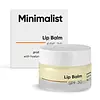What's inside
What's inside
 Key Ingredients
Key Ingredients

 Benefits
Benefits

 Concerns
Concerns

 Ingredients Side-by-side
Ingredients Side-by-side

Petrolatum
EmollientHydrogenated Polyisobutene
EmollientDiisopropyl Adipate
EmollientPropylene Glycol Dicaprylate/Dicaprate
EmollientC12-15 Alkyl Benzoate
AntimicrobialDiisopropyl Sebacate
EmollientMicrocrystalline Wax
Emulsion StabilisingC18-38 Alkyl Hydroxystearoyl Stearate
EmollientPersea Gratissima Butter
Skin ConditioningDiethylamino Hydroxybenzoyl Hexyl Benzoate
UV FilterCetearyl Alcohol
EmollientCeteareth-20
CleansingBehenyl Alcohol
EmollientNeopentyl Glycol Diheptanoate
EmollientPropylene Glycol Dibenzoate
Skin ConditioningCera Alba
EmollientEthylhexyl Triazone
UV AbsorberButyrospermum Parkii Butter
Skin ConditioningEuphorbia Cerifera Cera
AstringentOzokerite
Emulsion StabilisingTocopheryl Acetate
AntioxidantSodium Hyaluronate
HumectantBis-Ethylhexyloxyphenol Methoxyphenyl Triazine
Skin ConditioningCeramide NP
Skin ConditioningDiisostearyl Malate
EmollientEthylhexyl Palmitate
EmollientTrihydroxystearin
Skin ConditioningAmorphophallus Konjac Root Powder
AbrasiveBHT
AntioxidantPetrolatum, Hydrogenated Polyisobutene, Diisopropyl Adipate, Propylene Glycol Dicaprylate/Dicaprate, C12-15 Alkyl Benzoate, Diisopropyl Sebacate, Microcrystalline Wax, C18-38 Alkyl Hydroxystearoyl Stearate, Persea Gratissima Butter, Diethylamino Hydroxybenzoyl Hexyl Benzoate, Cetearyl Alcohol, Ceteareth-20, Behenyl Alcohol, Neopentyl Glycol Diheptanoate, Propylene Glycol Dibenzoate, Cera Alba, Ethylhexyl Triazone, Butyrospermum Parkii Butter, Euphorbia Cerifera Cera, Ozokerite, Tocopheryl Acetate, Sodium Hyaluronate, Bis-Ethylhexyloxyphenol Methoxyphenyl Triazine, Ceramide NP, Diisostearyl Malate, Ethylhexyl Palmitate, Trihydroxystearin, Amorphophallus Konjac Root Powder, BHT
Octyldodecanol
EmollientCaprylic/Capric Triglyceride
MaskingC10-18 Triglycerides
EmollientPEG-8 Beeswax
EmulsifyingPolyethylene
AbrasiveCera Alba
EmollientEuphorbia Cerifera Wax
Ethylhexyl Methoxycinnamate
UV AbsorberButyl Methoxydibenzoylmethane
UV AbsorberPetrolatum
EmollientGlycerin
HumectantBisabolol
MaskingPanthenol
Skin ConditioningTocopheryl Acetate
AntioxidantBHT
AntioxidantTocopherol
AntioxidantIngredients Explained
These ingredients are found in both products.
Ingredients higher up in an ingredient list are typically present in a larger amount.
BHT is a synthetic antioxidant and preservative.
As an antioxidant, it helps your body fight off free-radicals. Free-radicals are molecules that may damage your skin cells.
As a preservative, it is used to stabilize products and prevent them from degrading. Specifically, BHT prevents degradation from oxidation.
The concerns related to BHT come from oral studies; this ingredient is currently allowed for use by both the FDA and EU.
However, it was recently restricted for use in the UK as of April 2024.
Learn more about BHTCera alba is beeswax, or the wax used by bees to make honeycombs. It is a texture-enhancer and emollient. A study from 2003 found beeswax to be a stronger emollient than ingredients such as petroleum jelly.
As an emollient, beeswax helps hydrate the skin by creating a barrier on top. This barrier traps moisture in.
Emulsifiers help prevent ingredients from separating. This helps create consistent texture.
The structure of beeswax is mainly long-chain alcohols and the esters of fatty acids.
There are three types of beeswax: yellow, white, and absolute. Yellow is pure beeswax taken from the honeycomb. White beeswax is created by filtering or bleaching yellow beeswax. Absolute beeswax is created by treating beeswax with alcohol. Beeswax used in cosmetics are purified.
Beeswax has been used throughout history and even in prehistoric times. Some common uses for beeswax still used today are making candles, as a waterproofing agent, and polish for leather.
Learn more about Cera AlbaPetrolatum is more commonly known as petroleum jelly. It is created by mixing waxes and mineral oils.
This ingredient is effective at reducing water loss by 99%. This is because it is an occlusive. Occlusives create a hydrophobic barrier on the skin to prevent evaporation. This property makes it great for hydrating dry skin.
Pro tip: Use occlusives, such as this ingredient, on damp skin for the best results.
The quality or origin of petrolatum is only known when disclosed by the brand. Most cosmetic petrolatum has gone through several purification stages.
Another benefit of occlusives is it protects your skin against infection or allergies.
Petrolatum may not be safe for fungal-acne. Studies show mineral oil / petroleum leads to the growth of M. Furfur, a type of yeast.
Learn more about PetrolatumTocopheryl Acetate is AKA Vitamin E. It is an antioxidant and protects your skin from free radicals. Free radicals damage the skin by breaking down collagen.
One study found using Tocopheryl Acetate with Vitamin C decreased the number of sunburned cells.
Tocopheryl Acetate is commonly found in both skincare and dietary supplements.
Learn more about Tocopheryl Acetate